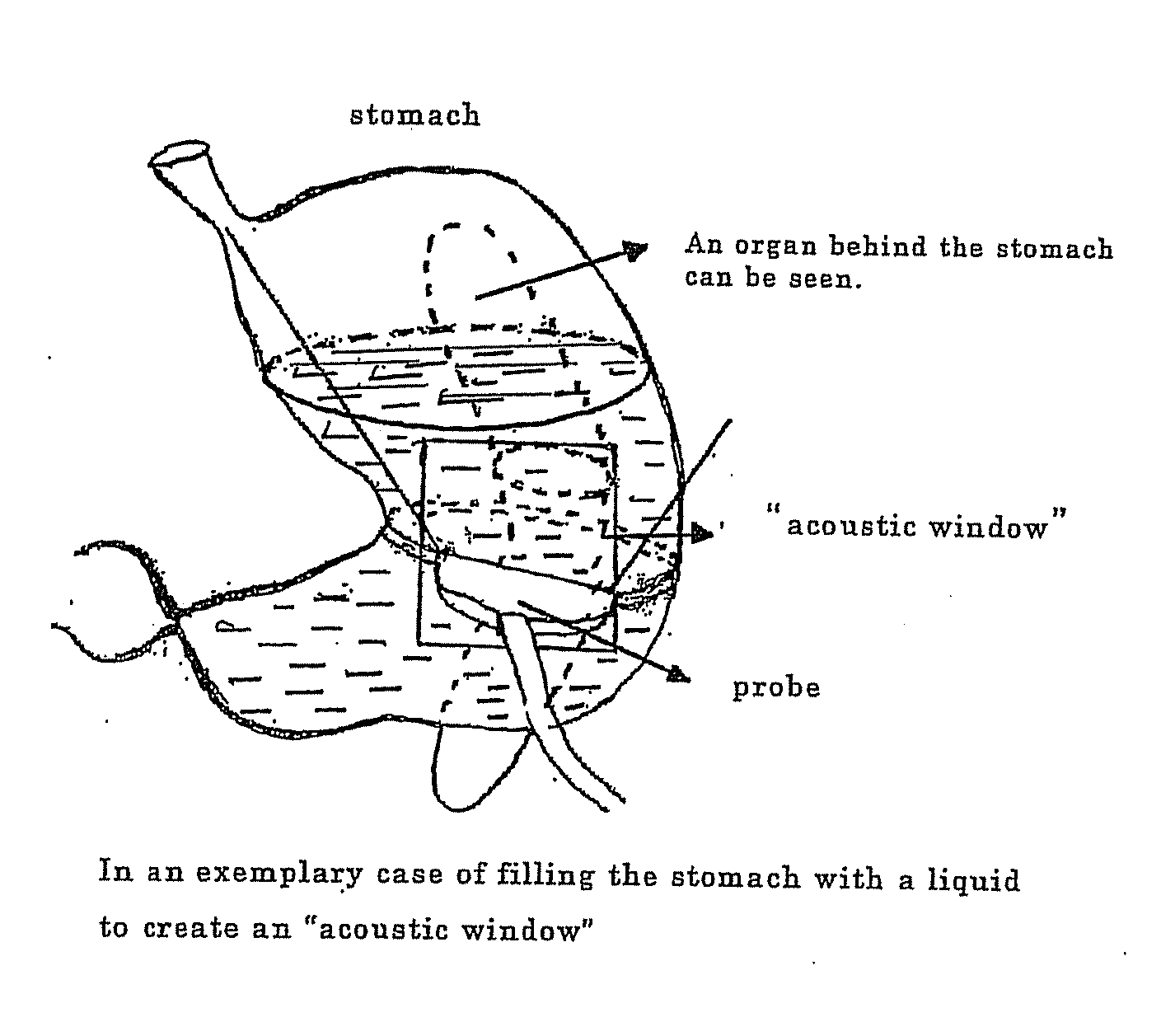Novel method of using triacetin and auxiliary agent for ultrasonic diagnostic examination
- Summary
- Abstract
- Description
- Claims
- Application Information
AI Technical Summary
Benefits of technology
Problems solved by technology
Method used
Image
Examples
example 1
Triacetin (0.5%)
[0083]To 200 mL of water under agitation with a magnetic stirrer, 1.5 g of triacetin, 0.24 g of citric acid and 1.74 g of trisodium citrate, both as a pH modifier, and 3 g of glycerin as a sweetener were added, followed by heating at 80° C.
[0084]Subsequently, 0.012 g of ethyl paraoxybenzoate and 0.027 g of butyl paraoxybenzoate that had been preliminarily dissolved in 0.45 g of propylene glycol were added; after cooling, a preliminarily prepared ethanol solution of 20% 1-menthol was added in such an amount that 0.006 g of 1-menthol would be incorporated and water was added to make a volume of 300 mL. As a result, a colorless and clear preparation was completed.
[0085]Thus, the completed preparation contains the following components (A) to (I) in 300 mL of water.
[0086]Since triacetin tastes bitter, additives and a method for eliminating the bitterness may optionally be used.
(A) triacetin: 1.5 g
(B) buffer: citric acid: 0.24 g
(C) buffer: trisodium citrate: 1.74 g
(D) swee...
example 2
Triacetin (0.5%)
[0087]To 200 mL of water under agitation with a magnetic stirrer, 1.5 g of triacetin, 0.24 g of citric acid and 1.74 g of trisodium citrate, both as a pH modifier, and 0.03 g of saccharin sodium as a sweetener were added, followed by heating at 80° C.
[0088]Subsequently, 0.012 g of ethyl paraoxybenzoate and 0.027 g of butyl paraoxybenzoate that had been preliminarily dissolved in 0.45 g of propylene glycol were added; after cooling, 3 g of glycine and a preliminarily prepared ethanol solution of 20% 1-menthol were added in such an amount that 0.006 g of 1-menthol would be incorporated and water was added to make a volume of 300 mL. As a result, a colorless and clear preparation was completed.
[0089]Thus, the completed preparation contains the following components (A) to (J) in 300 mL of water.
(A) triacetin: 1.5 g
(B) buffer: citric acid: 0.24 g
(C) buffer: trisodium citrate: 1.74 g
(D) sweetener: saccharin sodium: 0.03 g
(E) solvent promoter: propylene glycol: 0.45 g
(F) an...
example 3
Triacetin (10%)
[0090]Thirty grams of triacetin and 4.5 g of polyoxyethylene(30) hardened castor oil (Nikko Chemicals Co., Ltd.: NIKKOL HCO-30) were mixed to give the indicated proportions and agitated with a high-performance stirrer / disperser, ULTRA-TARAX (product of IKA JAPAN CO., LTD.) to yield a liquid mixture.
[0091]To 200 mL of water heated at about 70° C., 0.6 g of carmellose sodium (CELOGEN F-SC of DAI-ICHI KOGYO SEIYAKU CO., LTD.) was added under agitation with a magnetic stirrer to form a solution. After cooling to room temperature, 0.24 g of citric acid and 1.74 g of trisodium citrate, both as a pH modifier, and 0.03 g of saccharin sodium as a sweetener were added, followed by heating at 80° C.
[0092]Then, 0.012 g of ethyl paraoxybenzoate and 0.027 g of butyl paraoxybenzoate that had been preliminarily dissolved in 0.45 g of propylene glycol were added; after thorough agitation, the temperature of the liquid was lowered to about 50° C.
[0093]Subsequently, the whole quantity o...
PUM
| Property | Measurement | Unit |
|---|---|---|
| Mass | aaaaa | aaaaa |
| Volume | aaaaa | aaaaa |
| Volume | aaaaa | aaaaa |
Abstract
Description
Claims
Application Information
 Login to View More
Login to View More - R&D
- Intellectual Property
- Life Sciences
- Materials
- Tech Scout
- Unparalleled Data Quality
- Higher Quality Content
- 60% Fewer Hallucinations
Browse by: Latest US Patents, China's latest patents, Technical Efficacy Thesaurus, Application Domain, Technology Topic, Popular Technical Reports.
© 2025 PatSnap. All rights reserved.Legal|Privacy policy|Modern Slavery Act Transparency Statement|Sitemap|About US| Contact US: help@patsnap.com



